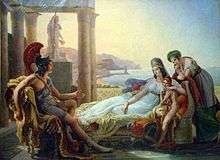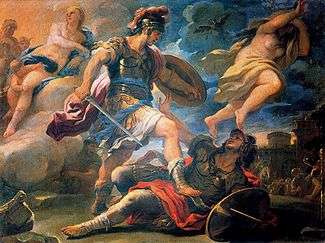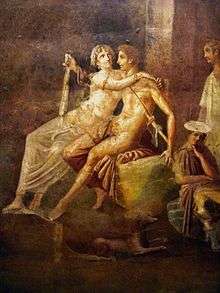Aeneas

In Greco-Roman mythology, Aeneas (/ᵻˈniːəs/;[1] Greek: Αἰνείας, Aineías, possibly derived from Greek αἰνή meaning "praised") was a Trojan hero, the son of the prince Anchises and the goddess Venus (Aphrodite). His father was a first cousin of King Priam of Troy (both being grandsons of Ilus, founder of Troy), making Aeneas a second cousin to Priam's children (such as Hector and Paris). He is a character in Greek mythology and is mentioned in Homer's Iliad. Aeneas receives full treatment in Roman mythology, most extensively in Virgil's Aeneid, where he is an ancestor of Romulus and Remus. He became the first true hero of Rome.
Name
Aeneas is the Latin spelling of Greek Αἰνείας (Aineías). In the Homeric Hymn to Aphrodite, Aeneas is first introduced with Aphrodite naming him Αἰνείας (Aineías) for the αὶνóν ἄχος ("terrible grief") he caused her, where Aineías derives from the adjective αὶνóν (ainon, meaning "terrible").[2] It is a popular etymology for the name, apparently exploited by Homer in the Iliad.[3] Later in the Medieval period there were writers who held that, because the Aeneid was written by a philosopher it is meant to be read philosophically.[4] As such, in the "natural order", the meaning of Aeneas' name combines Greek ennos ("dweller") and demas ("body"), which becomes ennaios, meaning "in-dweller" (i.e. as a god inhabiting a mortal body).[5] However, there is no certainty regarding the origin of his name.
Epithets
In imitation of the Iliad, Virgil borrows epithets of Homer, including; Anchisiades, magnanimum, magnus, heros, and bonus. Though he borrows many, Virgil gives Aeneas two epithets of his own in the Aeneid: pater and pius. The epithets applied by Virgil are an example of an attitude different from that of Homer, for whilst Odysseus is poikilios ("wily"), Aeneas is described as pius ("pious"), which conveys a strong moral tone. The purpose of these epithets seem to enforce the notion of Aeneas' divine hand as father and founder of the Roman race, and their use seem circumstantial: when Aeneas is praying he refers to himself as pius, and is referred to as such by the author only when the character is acting on behalf of the gods to fulfill his divine mission. Likewise, Aeneas is called pater when acting in the interest of his men.[6]
Greek myth and epos
Homeric Hymn to Aphrodite

The story of the birth of Aeneas is told in the "Hymn to Aphrodite," one of the major Homeric Hymns. Aphrodite has caused the other gods, especially Zeus, to fall in love with mortal women. In retaliation, Zeus puts desire in her heart for Anchises, who is tending his cattle among the hills near Mount Ida. When Aphrodite sees him she is smitten. She adorns herself as if for a wedding among the gods and appears before him. He is overcome by her beauty, believing that she is a goddess, but Aphrodite identifies herself as a Phrygian princess. After they make love, Aphrodite reveals her true identity to him and Anchises fears what might happen to him as a result of their liaison. Aphrodite assures him that he will be protected, and tells him that she will bear him a son to be called Aeneas. However, she warns him that he must never tell anyone that he has lain with a goddess. When Aeneas is born, Aphrodite takes him to the nymphs of Mount Ida. She directs them to raise the child to age five, then take him to Anchises.[7] According to other sources, Anchises later brags about his encounter with Aphrodite, and as a result is struck in the foot with a thunderbolt by Zeus. Thereafter he is lame in that foot, so that Aeneas has to carry him from the flames of Troy.[8]
Homer's Iliad
Aeneas is a minor character in the Iliad, where he is twice saved from death by the gods as if for an as-yet-unknown destiny, but is a warrior in his own right. Having held back from the fighting, aggrieved with Priam because in spite of his brave deeds he was not given his due share of honour, he leads an attack against Idomeneus to recover the body of his brother-in-law Alcathous at the urging of Deiphobus.[9] He is the leader of the Trojans' Dardanian allies, as well as a second cousin and principal lieutenant of Hector, son of the Trojan king Priam. Aeneas's mother Aphrodite frequently comes to his aid on the battlefield, and he is a favorite of Apollo. Aphrodite and Apollo rescue Aeneas from combat with Diomedes of Argos, who nearly kills him, and carry him away to Pergamos for healing. Even Poseidon, who normally favors the Greeks, comes to Aeneas's rescue after he falls under the assault of Achilles, noting that Aeneas, though from a junior branch of the royal family, is destined to become king of the Trojan people. Bruce Louden presents Aeneas as a "type" in the tradition of Utnapishtim, Baucis and Philemon, and Lot; the just man spared the general destruction.[10] Apollodorus explains that "...the Greeks let him alone on account of his piety".[11]
Other sources
The Roman mythographer Gaius Julius Hyginus (c. 64 BCE – CE 17) in his Fabulae[12] credits Aeneas with killing 28 enemies in the Trojan War. Aeneas also appears in the Trojan narratives attributed to Dares Phrygius and Dictys Cretensis.
Snorri Sturlason tells of the Trojans in the Prologue to his Edda.[13] He tells of a king of Troja, Munon or Menon, who marries the daughter of the High King (Yfirkonungr) Priam called Troan. They got a son, Tror, who, as Snorri tells, is identical to Thor. In the same Prologue Snorri tells of the world as parted in three continents: Africa, Asia and the third part is called Europe, and Enea as well.
Roman myth and literature

The history of Aeneas was continued by Roman authors. One influential source was the account of Rome's founding in Cato the Elder's Origines.[14] The Aeneas legend was well known in Virgil's day and appeared in various historical works, including the Roman Antiquities of the Greek historian Dionysius of Halicarnassus (relying on Marcus Terentius Varro), Ab Urbe Condita by Livy (probably dependent on Quintus Fabius Pictor, fl. 200 BCE), and Gnaeus Pompeius Trogus (now extant only in an epitome by Justin).
Virgil's Aeneid

The Aeneid explains that Aeneas is one of the few Trojans who were not killed or enslaved when Troy fell. Aeneas, after being commanded by the gods to flee, gathered a group, collectively known as the Aeneads, who then traveled to Italy and became progenitors of Romans. The Aeneads included Aeneas's trumpeter Misenus, his father Anchises, his friends Achates, Sergestus, and Acmon, the healer Iapyx, the helmsman Palinurus, and his son Ascanius (also known as Iulus, Julus, or Ascanius Julius). He carried with him the Lares and Penates, the statues of the household gods of Troy, and transplanted them to Italy.
Several attempts to find a new home failed; one such stop was on Sicily, where in Drepanum, on the island's western coast, his father, Anchises, died peacefully.

After a brief but fierce storm sent up against the group at Juno's request, Aeneas and his fleet made landfall at Carthage after six years of wanderings. Aeneas had a year-long affair with the Carthaginian queen Dido (also known as Elissa), who proposed that the Trojans settle in her land and that she and Aeneas reign jointly over their peoples. A marriage of sorts was arranged between Dido and Aeneas at the instigation of Juno, who was told that her favorite city would eventually be defeated by the Trojans' descendants. Aeneas's mother Venus (the Roman adaptation of Aphrodite) realized that her son and his company needed a temporary respite to reinforce themselves for the journey to come. However, the messenger god Mercury was sent by Jupiter and Venus to remind Aeneas of his journey and his purpose, compelling him to leave secretly. When Dido learned of this, she uttered a curse that would forever pit Carthage against Rome, an enmity that would culminate in the Punic Wars. She then committed suicide by stabbing herself with the same sword she gave Aeneas when they first met.
After the sojourn in Carthage, the Trojans returned to Sicily where Aeneas organized funeral games to honor his father, who had died a year before. The company traveled on and landed on the western coast of Italy. Aeneas descended into the underworld where he met Dido (who turned away from him to return to her husband) and his father, who showed him the future of his descendants and thus the history of Rome.

Latinus, king of the Latins, welcomed Aeneas's army of exiled Trojans and let them reorganize their lives in Latium. His daughter Lavinia had been promised to Turnus, king of the Rutuli, but Latinus received a prophecy that Lavinia would be betrothed to one from another land — namely, Aeneas. Latinus heeded the prophecy, and Turnus consequently declared war on Aeneas at the urging of Juno, who was aligned with King Mezentius of the Etruscans and Queen Amata of the Latins. Aeneas's forces prevailed. Turnus was killed, and Virgil's account ends abruptly.
Other sources
The rest of Aeneas's biography is gleaned from other ancient sources, including Livy and Ovid's Metamorphoses. According to Livy, Aeneas was victorious but Latinus died in the war. Aeneas founded the city of Lavinium, named after his wife. He later welcomed Dido's sister, Anna Perenna, who then committed suicide after learning of Lavinia's jealousy. After Aeneas's death, Venus asked Jupiter to make her son immortal. Jupiter agreed. The river god Numicus cleansed Aeneas of all his mortal parts and Venus anointed him with ambrosia and nectar, making him a god. Aeneas was recognized as the god Jupiter Indiges.[15]
Medieval accounts
Continuations of Trojan matter in the Middle Ages had their effects on the character of Aeneas as well. The 12th-century French Roman d'Enéas addresses Aeneas's sexuality. Though Virgil appears to deflect all homoeroticism onto Nisus and Euryalus, making his Aeneas a purely heterosexual character, in the Middle Ages there was at least a suspicion of homoeroticism in Aeneas. The Roman d'Enéas addresses that charge, when Queen Amata opposes Aeneas's marrying Lavinia, claiming that Aeneas loved boys.[16]
Medieval interpretations of Aeneas were greatly influenced by both Virgil and other Latin sources. Specifically, the accounts by Dares and Dictys, which were reworked by 13th-century Italian writer Guido delle Colonne (in Historia destructionis Troiae), colored many later readings. From Guido, for instance, the Pearl Poet and other English writers get the suggestion[17] that Aeneas's safe departure from Troy with his possessions and family was a reward for treason, for which he was chastised by Hecuba.[18] In Sir Gawain and the Green Knight (late 14th century) the Pearl Poet, like many other English writers, employed Aeneas to establish a genealogy for the foundation of Britain,[17] and explains that Aeneas was "impeached for his perfidy, proven most true" (line 4).[19]
Family and legendary descendants

Aeneas had an extensive family tree. His wet-nurse was Caieta,[20] and he is the father of Ascanius with Creusa, and of Silvius with Lavinia. Ascanius, also known as Iulus (or Julius),[21] founded Alba Longa and was the first in a long series of kings. According to the mythology outlined by Virgil in the Aeneid, Romulus and Remus were both descendants of Aeneas through their mother Rhea Silvia, making Aeneas the progenitor of the Roman people.[22] Some early sources call him their father or grandfather,[23] but considering the commonly accepted dates of the fall of Troy (1184 BC) and the founding of Rome (753 BC), this seems unlikely. The Julian family of Rome, most notably Julius Cæsar and Augustus, traced their lineage to Ascanius and Aeneas,[24] thus to the goddess Venus. Through the Julians, the Palemonids make this claim. The legendary kings of Britain – including King Arthur – trace their family through a grandson of Aeneas, Brutus.[25]
Character and physical appearance

Aeneas's consistent epithet in Virgil and other Latin authors is pius, a term that connotes reverence toward the gods and familial dutifulness.
In the Aeneid, Aeneas is described as strong and handsome, but neither his hair colour nor complexion are described.[26] In late antiquity however sources add further physical descriptions. The De excidio Troiae of Dares Phrygius describes Aeneas as ‘‘auburn-haired, stocky, eloquent, courteous, prudent, pious, and charming.’’[27] There is also a brief physical description found in John Malalas' Chronographia: ‘‘Aeneas: short, fat, with a good chest, powerful, with a ruddy complexion, a broad face, a good nose, fair skin, bald on the forehead, a good beard, grey eyes.’’[28]
Modern portrayals
Literature
Aeneas and Dido are the main characters of a 17th-century broadside ballad called "The Wandering Prince of Troy." The ballad ultimately alters Aeneas's fate from traveling on years after Dido's death to joining her as a spirit soon after her suicide.[29]
In modern literature, Aeneas is the speaker in two poems by Allen Tate, "Aeneas at Washington" and "Aeneas at New York." He is a main character in Ursula K. Le Guin's Lavinia, a re-telling of the last six books of the Aeneid told from the point of view of Lavinia, daughter of King Latinus of Latium.
Aeneas appears in David Gemmell's Troy series as a main heroic character who goes by the name Helikaon.
In Rick Riordan's book series, The Heroes of Olympus, Aeneas is regarded as the first Roman demigod, son of Venus rather than Aphrodite.
Opera, film and other media
Aeneas is a title character in Henry Purcell's opera Dido and Aeneas (c. 1688), and one of the principal roles in Hector Berlioz' opera Les Troyens (c. 1857).
Despite its many dramatic elements, Aeneas's story has generated little interest from the film industry. Portrayed by Steve Reeves, he was the main character in the 1961 sword and sandal film Guerra di Troia (The Trojan War). Reeves reprised the role the following year in the film The Avenger, about Aeneas's arrival in Latium and his conflicts with local tribes as he tries to settle his fellow Trojan refugees there.
The most recent cinematic portrayal of Aeneas was in the film Troy, in which he appears as a youth charged by Paris to protect the Trojan refugees, and to continue the ideals of the city and its people. Paris gives Aeneas Priam's sword, in order to give legitimacy and continuity to the royal line of Troy – and lay the foundations of Roman culture. In this film, he is not a member of the royal family and does not appear to fight in the war.
In the role-playing game Vampire: The Requiem by White Wolf Game Studios, Aeneas figures as one of the mythical founders of the Ventrue Clan.
in the action game Warriors: Legends of Troy, Aeneas is a playable character. The game ends with him and the Aeneans fleeing Troy's destruction and, spurned by the words of a prophetess thought crazed, goes to a new country (Italy) where he will start an empire greater than Greece and Troy combined that shall rule the world for 1000 years, never to be outdone in the tale of men (The Roman Empire).
Depictions in art
Scenes depicting Aeneas, especially from the Aeneid, have been the focus of study for centuries. They have been the frequent subject of art and literature since their debut in the 1st century.
Villa Valmarana
The artist Giovanni Battista Tiepolo was commissioned by Gaetano Valmarana in 1757 to fresco several rooms in the Villa Valmarana, the family villa situated outside Vicenza. Tiepolo decorated the palazzina with scenes from epics such as Homer's Iliad and Virgil's Aeneid.[30]
 Aeneas Introducing Cupid Dressed as Ascanius to Dido, by Tiepolo (1757). |
 Venus Appearing to Aeneas on the Shores of Carthage, by Tiepolo (1757). |
 Mercury Appearing to Aeneas, by Tiepolo (1757). |
 Venus and Vulcan, by Tiepolo (between 1762 and 1766). |
Aeneas flees Troy
 Flight of Aeneas from Troy, by Girolamo Genga (between 1507 and 1510). |
Aeneas and his Father Fleeing Troy, by Simon Vouet (c. 1635). |
 Aeneas & Anchises, by Pierre Lepautre (c. 1697). |
 Aeneas fleeing from Troy, by Pompeo Batoni (c. 1750). |
Aeneas with Dido
 Dido and Aeneas, by Rutilio Manetti (c. 1630) |
 The Meeting of Dido and Aeneas, by Nathaniel Dance-Holland |
 Landscape with Dido and Aeneas, by Thomas Jones (1769) |
 Dido meeting Aeneas, by Johann Heinrich the Elder Tischbein (3 January 1780) |
Family tree
See also
References
- ↑ "Aeneas". Merriam-Webster. 2015. Retrieved 2015-07-14.
- ↑ Gregory Nagy (Translator), Homeric Hymn to Aphrodite 198-199: "His name will be Aineias [Aeneas], since it was an unspeakable [ainos] akhos that took hold of me—grief that I had fallen into the bed of a mortal man."
- ↑ Andrew Faulkner, The Homeric Hymn to Aphrodite: Introduction, Text, and Commentary (2008) p.257
- ↑ Marilynn Desmond, Reading Dido: Gender, Textuality, and Medieval Aeneid (1994) pp. 85-86
- ↑ John of Salisbury, Polycraticus 8.24-25; Bernard Sylvestris of Tours, Commentum supra sex libros Eneidos Vergilii
- ↑ Milman Parry (Author), Adam Parry (Editor), The Making of Homeric Verse: The Collected Papers of Milman Parry (1971) p.169
- ↑ "Homeric Hymn to Aphrodite." trans by Gregory Nagy, University of Houston.
- ↑ Virgil, The Aeneid
- ↑ Homer, The Iliad, Book XIII, (Samuel Butler, trans.)
- ↑ Louden, Bruce. "Aeneas in the Iliad: the One Just Man", 102nd Annual Meeting of CAMWS, Classical Association of the Middle West and South, 2006
- ↑ Apollodorus, Epitome, (James G. Frazer ed.), Chap.V, 21
- ↑ Hyginus, Fabulae 115.
- ↑ http://heimskringla.no/wiki/Prologus
- ↑ Stout, S.E. (1924). "How Vergil Established for Aeneas a Legal Claim to a Home and a Throne in Italy". The Classical Journal. 20 (3): 152–60. JSTOR 3288552.
- ↑ Titus Livius. The History of Rome, (Rev. Canon Roberts, trans.), Vol. I, J. M. Dent & Sons, Ltd., London, 1905
- ↑ Eldevik, Randi (1991). "Negotiations of Homoerotic Tradition". PMLA. 106 (5): 1177–78. doi:10.2307/462692. JSTOR 462692.
- 1 2 Tolkien, J. R. R.; E. V. Gordon; Norman Davis, eds. (1967). Sir Gawain and the Green Knight (2 ed.). Oxford: Oxford UP. p. 70. ISBN 9780198114864.
- ↑ Colonne, Guido delle (1936). Griffin, N. E., ed. Historia destructionis Troiae. Medieval Academy Books. 26. Cambridge: Medieval Academy of America. pp. 218, 234.
- ↑ Laura Howes, ed. (2010). Sir Gawain and the Green Knight. Marie Boroff (trans.). New York: Norton. p. 3. ISBN 9780393930252. In Marie Boroff's translation, edited by Laura Howes, the treacherous knight of line 3 is identified as Antenor, incorrectly, as Tolkien argues.
- ↑ Vergil Aeneid 7.1-4
- ↑ Vergil, Aeneid 1983 1.267
- ↑ C. F. L'Homond Selections from Viri Romae p.1
- ↑ Romulus by Plutarch
- ↑ Dionysius of Halicarnassus Roman Antiquities I.70.4
- ↑ Charles Selby Events to be Remembered in the History of Britain p.1-2
- ↑ What Does Aeneas Look like?, Mark Griffith, Classical Philology, Vol. 80, No. 4 (Oct., 1985), p. 309.
- ↑ "Classical E-Text: Dares Phrygius, The Fall Of Troy". Theoi.com. Retrieved 2012-08-28.
- ↑ Lowden, John. Illuminated prophet books: a study of Byzantine manuscripts of the major and minor prophets Penn State Press, 1988, p. 62
- ↑ English Broadside Ballad Archive, ballad facsimile and full text
- ↑ Michael Collins, Elise K. Kirk ed. Opera and Vivaldi p. 150
Sources
| Wikimedia Commons has media related to Aeneas. |
| Wikisource has the text of the 1911 Encyclopædia Britannica article Aeneas. |
- Homer, Iliad II. 819–21; V. 217–575; XIII. 455–544; XX. 75–352.
- Apollodorus, Bibliotheca III. xii. 2; Epitome III. 32–IV. 2; V. 21.
- Virgil, Aeneid.
- Ovid, Metamorphoses XIII. 623-715; XIV. 75-153; 581–608.
- Ovid, Heroides, VII.
- Livy, Book 1.1-2.
- Dictys Cretensis.
- Dares Phrygius.
| Legendary titles | ||
|---|---|---|
| Preceded by Latinus |
Latin king | Succeeded by Ascanius |

